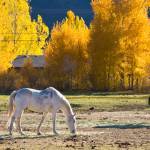Nutritionist Q&A: Winter Care for Senior Horses

Q: In preparation for winter, I am trying to decide how best to feed my collection of aged school horses, all of which will be in seasonal retirement and living outdoors, rugged as needed. They stay in good weight when in work and fed normal-sized (about 6 lb or 2.7 kg) concentrate meals and as much good-quality pasture as they choose. Should I add more fat and fiber to their diets this winter? Which would be better?
A: Horses should be fed as individuals, taking into consideration their age, workload, rate of metabolism, and other factors. Although specific feeding recommendations cannot be made based on the information provided, it is possible to offer some points to consider when deciding how to feed your horses as the air chills. Fiber-rich forage is the most fundamental component of any horse’s diet. In the winter, horsemen generally rely upon hay to fulfill fiber needs, though some horses will also scavenge dormant pastures for variety. Free-choice access to hay ensures that horses have sufficient calories to remain warm during even the most inclement weather, perhaps with the exception of freezing rain.
The quality of the hay offered will depend upon the horses’ energy needs. Because the horses have transitioned from light- or moderate-intensity work to mere maintenance, mid-quality hay in addition to their usual concentrate meals may be sufficient to maintain optimal weight. Be leery of stemmy poor-quality hay, because horses might not digest it well, and it can cause impactions and a pot-bellied appearance.
If horses are kept warm with blankets and forage, you might find the horses actually gaining weight, particularly if mild weather prevails. In this situation, a reduction in the amount of concentrate might be necessary. Be sure you follow the manufacturer’s feeding directions, as too little feed could result in insufficient vitamin and mineral intake.
Certain horses might not be able to maintain weight in winter despite recommended levels of fortified feed, all the hay they can eat, blanketing, and a suitable windbreak. These horses might need additional calories, and one way to do this is through the use of fat. Fat is usually added in one of two ways, as part of the concentrate (as in a high-fat feed) or as a supplement (stabilised rice bran or vegetable oil). Oils are pure fat, so they pack a significant caloric punch, and horses usually consume oil readily.
In summary, neither fiber nor fat is better than the other. Fiber is an essential element of the diet, and sources of fiber have different nutrient specifications. Fat is an optional element but a useful one when calories are needed. Weekly or biweekly monitoring of body condition is essential. In the winter, when coats are long and shaggy, it is important for horsemen to feel for fat cover over certain body areas such as the ribcage. By keeping an informal record of their findings, horsemen should be able to pick up on differences so dietary adjustments can be made before a dramatic swing in weight occurs.
Do you have a question about how to properly nourish your old horse? Contact the KER nutrition advisors for a complete nutritional inventory of your horse’s diet. Start here!








